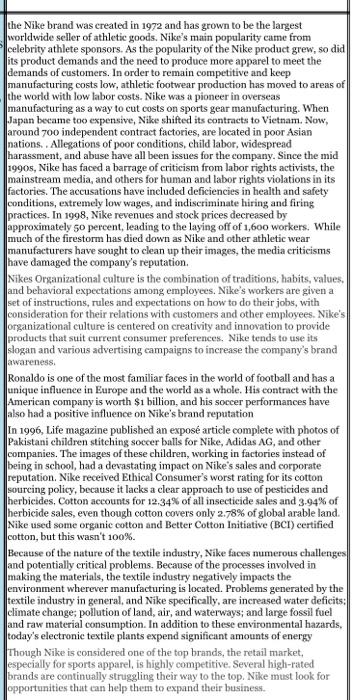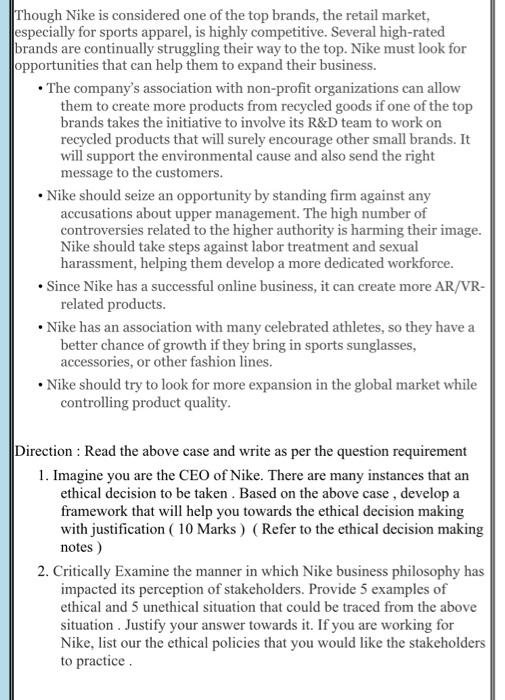the Nike brand was created in 1972 and has grown to be the largest worldwide seller of athletic goods. Nike's main popularity came from celebrity athlete sponsors. As the popularity of the Nike product grew, so did its product demands and the need to produce more apparel to meet the demands of customers. In order to remain competitive and keep manufacturing costs low, athletic footwear production has moved to areas of the world with low labor costs. Nike was a pioneer in overseas manufacturing as a way to cut costs on sports gear manufacturing. When Japan became too expensive, Nike shifted its contracts to Vietnam. Now, around 7oo independent contract factories, are located in poor Asian nations. . Allegations of poor conditions, child labor, widespread harassment, and abuse have all been issues for the company. Since the mid 19905, Nike has faced a barrage of criticism from labor rights activists, the mainstream media, and others for human and labor rights violations in its factories. The accusations have included deficiencies in health and safety conditions, extremely low wages, and indiscriminate hiring and firing practices. In 1998, Nike revenues and stock prices decreased by approximately 50 percent, leading to the laying off of 1,600 workers. While much of the firestorm has died down as Nike and other athletic wear manufacturers have sought to clean up their images, the media criticisms have damaged the company's reputation. Nikes Organizational culture is the combination of traditions, habits, values, and behavioral expectations among employees. Nike's workers are given a set of instructions, rules and expectations on how to do their jobs, with consideration for their relations with customers and other employees. Nike's organizational culture is centered on creativity and innovation to provide products that suit current consumer preferences. Nike tends to use its slogan and various advertising eampaigns to increase the company's brand awareness, Ronaldo is one of the most familiar faces in the world of football and has a unique influence in Europe and the world as a whole. His contract with the American company is worth $1 billion, and his soccer performances have also had a positive influence on Nike's brand reputation In 1996, Life magazine published an expos article complete with photos of Pakistani children stitching soccer balls for Nike, Adidas AG, and other companies. The images of these children, working in factories instead of being in school, had a devastating impact on Nike's sales and corporate reputation. Nike received Ethical Consumer's worst rating for its cotton sourcing policy, because it lacks a clear approach to use of pesticides and herbicides, Cotton accounts for 12.34% of all insecticide sales and 3.94% of herbicide sales, even though cotton covers only 2.78% of global arable land. Nike used some organic cotton and Better Cotton Initiative (BCI) certified cotton, but this wasn't 100%. Because of the nature of the textile industry, Nike faces numerous challenges and potentially critical problems. Because of the processes involved in making the materials, the textile industry negatively impacts the environment wherever manufacturing is located. Problems generated by the textile industry in general, and Nike specifically, are increased water deficits: climate change; pollution of land, air, and waterways; and large fossil fuel and rav material consumption. In addition to these environmental hazards, today's electronic textile plants expend significant amounts of energy Though Nike is considered one of the top brands, the retail market, especially for sports apparel, is highly competitive. Several high-rated brands are continually struggling their way to the top. Nike must look for opportunities thut can help them to expand their business. Though Nike is considered one of the top brands, the retail market, especially for sports apparel, is highly competitive. Several high-rated brands are continually struggling their way to the top. Nike must look for opportunities that can help them to expand their business. - The company's association with non-profit organizations can allow them to create more products from recycled goods if one of the top brands takes the initiative to involve its R\&D team to work on recycled products that will surely encourage other small brands. It will support the environmental cause and also send the right message to the customers. - Nike should seize an opportunity by standing firm against any accusations about upper management. The high number of controversies related to the higher authority is harming their image. Nike should take steps against labor treatment and sexual harassment, helping them develop a more dedicated workforce. - Since Nike has a successful online business, it can create more AR/VRrelated products. - Nike has an association with many celebrated athletes, so they have a better chance of growth if they bring in sports sunglasses, accessories, or other fashion lines. - Nike should try to look for more expansion in the global market while controlling product quality. Direction : Read the above case and write as per the question requirement 1. Imagine you are the CEO of Nike. There are many instances that an ethical decision to be taken. Based on the above case , develop a framework that will help you towards the ethical decision making with justification ( 10 Marks ) (Refer to the ethical decision making notes) 2. Critically Examine the manner in which Nike business philosophy has impacted its perception of stakeholders. Provide 5 examples of ethical and 5 unethical situation that could be traced from the above situation. Justify your answer towards it. If you are working for Nike, list our the ethical policies that you would like the stakeholders to practice









